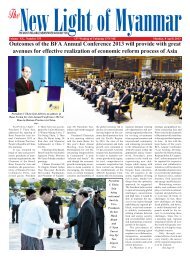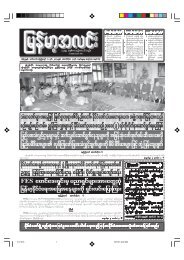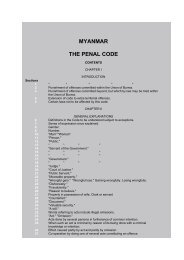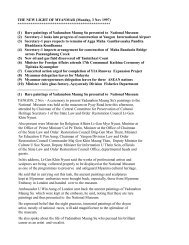Changing Buddhist Practice in Burma - Online Burma Library
Changing Buddhist Practice in Burma - Online Burma Library
Changing Buddhist Practice in Burma - Online Burma Library
Create successful ePaper yourself
Turn your PDF publications into a flip-book with our unique Google optimized e-Paper software.
support. Accord<strong>in</strong>g to Ferguson (1978: 70), Sangha was composed of<br />
different sects, and the rise of a particular sect was often correlated with the<br />
rise of new k<strong>in</strong>gs. In other words, a new k<strong>in</strong>g would nom<strong>in</strong>ate a new sect,<br />
rather than the one sponsored by the previous k<strong>in</strong>g, and both k<strong>in</strong>g and Sangha<br />
found their respective legitimation <strong>in</strong> this new cycle.<br />
When a new sect came to be associated with the powerful, its rival would<br />
'respond' <strong>in</strong> opposition by retreat<strong>in</strong>g <strong>in</strong>to the forest and adopt<strong>in</strong>g different<br />
monastic rules and norms. Similarly, with his rise to political power, after<br />
nom<strong>in</strong>at<strong>in</strong>g the official Sangha, the Burmese k<strong>in</strong>g would construct and reside<br />
<strong>in</strong> a new city, donate new pagodas and monasteries, and appo<strong>in</strong>t new<br />
m<strong>in</strong>isters, both at court level and as representatives <strong>in</strong> remote regions<br />
(Ferguson 1978: 67-83). The advent and subsequent growth of the Shwegy<strong>in</strong><br />
sect, contended Ferguson (1978: 71-5), <strong>in</strong> <strong>Burma</strong> <strong>in</strong> 19 th - 20 th centuries was<br />
due to the political process of the quest for legitimacy associated with the<br />
accession of K<strong>in</strong>g M<strong>in</strong>don, who reigned from 1853 to 1878.<br />
The survival and ma<strong>in</strong>tenance of Buddhism depended on k<strong>in</strong>g and his polity.<br />
K<strong>in</strong>g and Sangha <strong>in</strong>teracted and related to each other <strong>in</strong> reciprocal as well as<br />
antagonistic relationships. In the reciprocal relationship "K<strong>in</strong>gship, as the crux<br />
of order <strong>in</strong> society, provides the conditions and the context for the survival of<br />
sasana (religion). They need each other: religion <strong>in</strong> be<strong>in</strong>g supported by an<br />
ordered and prosperous society is able to act as the 'field of merit' <strong>in</strong> which<br />
merit mak<strong>in</strong>g can be enacted and its fruits enjoyed, while the k<strong>in</strong>g as the<br />
34
















